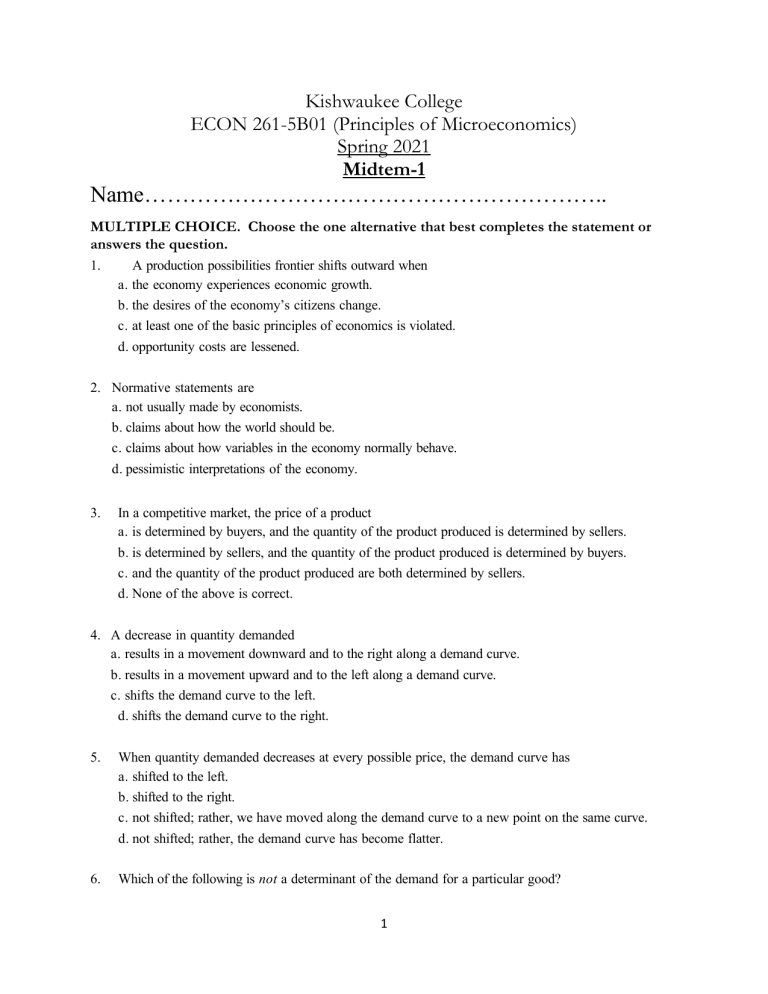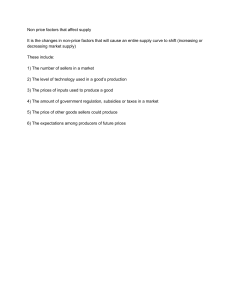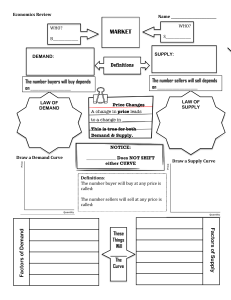
Kishwaukee College ECON 261-5B01 (Principles of Microeconomics) Spring 2021 Midtem-1 Name…………………………………………………….. MULTIPLE CHOICE. Choose the one alternative that best completes the statement or answers the question. 1. A production possibilities frontier shifts outward when a. the economy experiences economic growth. b. the desires of the economy’s citizens change. c. at least one of the basic principles of economics is violated. d. opportunity costs are lessened. 2. Normative statements are a. not usually made by economists. b. claims about how the world should be. c. claims about how variables in the economy normally behave. d. pessimistic interpretations of the economy. 3. In a competitive market, the price of a product a. is determined by buyers, and the quantity of the product produced is determined by sellers. b. is determined by sellers, and the quantity of the product produced is determined by buyers. c. and the quantity of the product produced are both determined by sellers. d. None of the above is correct. 4. A decrease in quantity demanded a. results in a movement downward and to the right along a demand curve. b. results in a movement upward and to the left along a demand curve. c. shifts the demand curve to the left. d. shifts the demand curve to the right. 5. When quantity demanded decreases at every possible price, the demand curve has a. shifted to the left. b. shifted to the right. c. not shifted; rather, we have moved along the demand curve to a new point on the same curve. d. not shifted; rather, the demand curve has become flatter. 6. Which of the following is not a determinant of the demand for a particular good? 1 a. the prices of related goods b. income c. tastes d. the prices of the inputs used to produce the good 7. Each of the following is a determinant of demand except a. tastes. b. production technology. c. expectations. d. the prices of related goods. 8. If a good is normal, then an increase in income will result in a(n) a. increase in the demand for the good. b. decrease in the demand for the good. c. movement down and to the right along the demand curve for the good. d. movement up and to the left along the demand curve for the good. 9. If a decrease in income increases the demand for a good, then the good is a(n) a. substitute good. b. complementary good. c. normal good. d. inferior good. 10. Suppose that a decrease in the price of good X results in fewer units of good Y being demanded. This implies that X and Y are a. complementary goods. b. normal goods. c. inferior goods. d. substitute goods. 11. In general, elasticity is a measure of a. the extent to which advances in technology are adopted by producers. b. the extent to which a market is competitive. c. how firms’ profits respond to changes in market prices. d. how much buyers and sellers respond to changes in market conditions. 12. Demand is elastic if the price elasticity of demand is a. less than 1. b. equal to 1. c. equal to 0. 2 d. greater than 1. 13. Which of the following is not a determinant of the price elasticity of demand for a good? a. the time horizon b. the steepness or flatness of the supply curve for the good c. the definition of the market for the good d. the availability of substitutes for the good 14. If a 10% decrease in price for a good results in a 20% increase in quantity demanded, the price elasticity of demand is a. 0.50. b. 1. c. 1.5. d. 2. 15. When demand is perfectly inelastic, the price elasticity of demand a. is zero, and the demand curve is vertical. b. is zero, and the demand curve is horizontal. c. approaches infinity, and the demand curve is vertical. d. approaches infinity, and the demand curve is horizontal. 16. If the demand for bananas is elastic, then an increase in the price of bananas will a. increase total revenue of banana sellers. b. decrease total revenue of banana sellers. c. not change total revenue of banana sellers. d. There is not enough information to answer this question. 17. Holding all other forces constant, if decreasing the price of a good leads to an increase in total revenue, then the demand for the good must be a. unit elastic. b. inelastic. c. elastic. d. None of the above is correct because a price decrease never leads to an increase in total revenue. 18. Consumer surplus is the a. amount of a good consumers get without paying anything. b. amount a consumer pays minus the amount the consumer is willing to pay. c. amount a consumer is willing to pay minus the amount the consumer actually pays. d. value of a good to a consumer 3 19. All else equal, what happens to consumer surplus if the price of a good increases? a. Consumer surplus increases. b. Consumer surplus decreases. c. Consumer surplus is unchanged. d. Consumer surplus may increase, decrease, or remain unchanged. 20. Suppose the demand for peanuts increases. What will happen to producer surplus in the market for peanuts? a. It increases. b. It decreases. c. It remains unchanged. d. It may increase, decrease, or remain unchanged. 21. Total surplus is a. the total cost to sellers of providing the good minus the total value of the good to buyers. b. the total value of the good to buyers minus the cost to sellers of providing the good. c. the difference between consumer surplus and sellers’ cost. d. always smaller than producer surplus. 22. Suppose that when the price of good X increases from $800 to $850, the quantity demanded of good Y increases from 65 to 70. Using the midpoint method, the cross price elasticity of demand is about a. -1.2, and X and Y are complements. b. -0.1, and X and Y are complements. c. 0.1, and X and Y are substitutes. d. 1.2, and X and Y are substitutes. 23. Which of the following would not shift the supply curve for mp3 players? a. an increase in the price of mp3 players b. a decrease in the number of sellers of mp3 players c. an increase in the price of plastic, an input into the production of mp3 players d. an improvement in the technology used to produce mp3 players 24. The sum of all the individual demand curves for a product is called a) income demand. b) equilibrium demand. c) complementary demand. d) market demand. 4 Figure 1-1 Panel (a) Panel (b) 25. Refer to Figure 1-1. The rate of tradeoff between producing chairs and producing couches is constant in a. Panel (a). b. Panel (b). c. both Panel (a) and Panel (b). d. neither Panel (a) nor Panel (b). 26. The opportunity cost of an item is a. the number of hours needed to earn money to buy the item. b. what you give up to get that item. c. usually less than the dollar value of the item. d. the dollar value of the item. 27. When an externality is present, the market equilibrium is a. efficient, and the equilibrium maximizes the total benefit to society as a whole. b. efficient, but the equilibrium does not maximize the total benefit to society as a whole. c. inefficient, but the equilibrium maximizes the total benefit to society as a whole. d. inefficient, and the equilibrium does not maximize the total benefit to society as a whole. 28. Private markets fail to account for externalities because a. externalities don't occur in private markets. b. sellers include costs associated with externalities in the price of their product. c. Decision makers in the market fail to include the costs of their behavior to third parties. d. the government cannot easily estimate the optimal quantity of pollution 5 29. The impact of one person's actions on the well-being of a bystander is called a. an economic dilemma. b. deadweight loss. c. a multi-party problem. d. an externality. 30. The proposition that if private parties can bargain without cost over the allocation of resources, they can solve the problem of externalities on their own, is called a. the Pigovian theorem. b. a corrective tax. c. the externality theorem. d. the Coase theorem. 31. Which of the following statements about private goods and public goods is correct? a. Private goods and public goods are both excludable. b. Private goods and public goods are both rival in consumption. c. Private goods are not excludable and public goods are excludable. d. Private goods are rival in consumption and public goods are not excludable 32. Consider a good for which the number of people who benefit from the good is large and the exclusion of any one those people is impossible. In this case, the market for this good will likely a. be provided by a private firm rather than the government. b. have a free-rider problem. c. not exist. d. be limited to a small number of units of production. 33. Excludability is the property of a good whereby a) one person's use diminishes other peoples’ use. b) a person can be prevented from using it. c) the government rations the quantity of a good that is available. d) the resource is congestible. 34. If one person's use of a good diminishes another person's enjoyment of it, the good is a. rival in consumption. b. excludable. c. normal. d. exhaustible. 35. The value and cost of goods are easiest to determine when the goods are 6 a) b) c) d) private goods. public goods. common resources. club goods. 36. Which of the following goods is rival and excludable? a. an uncongested toll road b. an uncongested non-toll road c. a congested non-toll road d. a congested toll road 37. A streetlight is a a) private good. b) club good. c) common resource. d) public good. 38. According to the law of diminishing marginal utility: a) Utility is at a maximum with the first unit b) Increasing units of consumption increase the marginal utility c) Marginal product will fall as more units are consumed d) Total utility will rise at a falling rate as more units are consumed 39. If marginal utility is zero: a) b) c) d) 40. Total utility is zero An additional unit of consumption will decrease total utility An additional unit of consumption will increase total utility Total utility is maximized An Economy’s Marginal benefit curve for a public good is calculated by: a) Summing individual’s marginal benefit curves vertically b) Summing individual’s marginal benefit curves horizontally c) Averaging individual’s marginal benefit curves vertically d) Summing individual’s marginal benefit curves horizontally 7 Kishwaukee College ECON 261-5B01 (Principles of Microeconomics) Spring 2021 Answer Key: Template Name…………………………………………………….. Question No. 1 2 3 4 5 6 7 8 9 10 11 12 13 14 15 16 17 18 19 20 Answer Question No. 21 22 23 24 25 26 27 28 29 30 31 32 33 44 35 36 37 38 39 40 Answer








